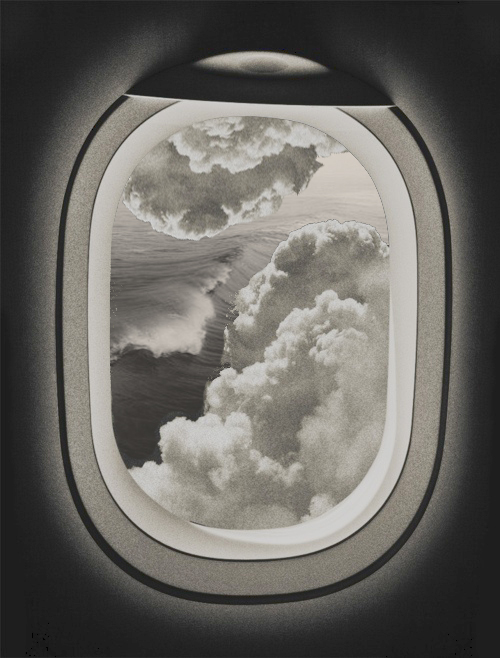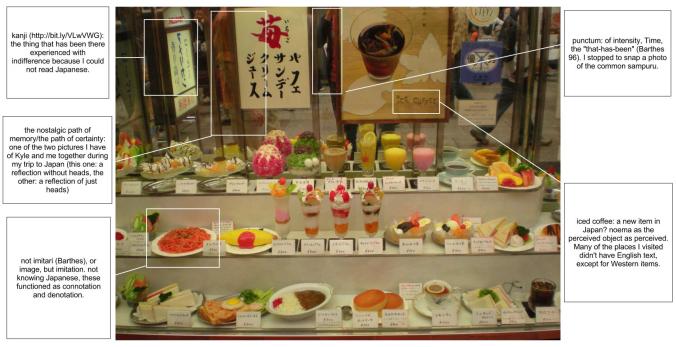[ENGL 527]
Discussion question for class:
Barthes describes photography as “that-has-been” or the “Intractable” (hard to control or deal with) (77). Images that would have been taken may have been monumental (like monuments) of person, time, place, but as photography became/becomes more accessible, it becomes more visible, or things, people, and places do as we photograph them. He goes on to say that in our daily flood of photographs (and this having come out in 1980, situate that in time now to the nth degree), the forms of interest photographs provoke may be experienced with indifference as a feature that goes without saying (77) – causing an almost skimming of the photographs we encounter, only pausing when punctum pricks our attention. He describes this submitting to the flatness of photography through likening the action to the camera lucida, an apparatus that allowed drawing an object through a prism, from the eye’s viewpoint as “the essence of the image is to be altogether outside, without intimacy, and yet more inaccessible and mysterious than the thought of the innermost being; without signification, yet summoning up the depth of any possible meaning; unrevealed yet manifest, having the absence-as-presence which constitutes the lure and the fascination of the Sirens” (quoting Blanchot 106). Reading this, I couldn’t help but situate this within the web, though image/photograph heavy in its design/function/use, focused more particularly through image-centric sites such as FFFFOUND!, Tumblr, Pinterest, Flickr, etc. How does the web shape punctum in these galleries of “Save Image As” or share with _________? Does the screen operate as a camera lucida? How does (or doesn’t) “intractable” take on new meaning in digital spaces, particularly regarding origin/source of the “that-has-been” (but-from-where)?
Reading Notes:
Citation: Barthes, Roland. Camera Lucida: Reflections on Photography. New York: Hill and Wang. 1980. Print.
Summary:
Barthes explains Photography as that-has-been, as representation – not Photography of just an image, but a just image (justesse) – that authenticates the existence of a being in Time, that in that moment, is reversed to photographic ecstasy (the nostalgia and certainty the photo elicits in that it is evidential and exclamative (113)).
Key Words:
- ur-doxa
- noeme
- camera obscura/lucida
- satori
- animula
- (new) punctum: of intensity – Time
- flat Death
- acheiropoietos
- anamnesis
- ecstasy
Passages to Keep:
“I remember keeping for a long time a photograph I had cut out of a magazine – lost subsequently, like everything too carefully put away…” (80).
“The Photograph does not call upon the past (nothing Proustian in a photograph). The effect it produces upon me is not to restore what has been abolished (by time, by distance) but to attest that what I see has indeed existed” (82).
“Mad or tame? Photography can be one or the other: tame if its realism remains relative, tempered by aesthetic or empirical habits (to leaf through a magazine at the hair dresser’s, the dentist’s); mad if this realism is absolute and, so to speak, original, obliging the loving and terrified consciousness to return to the very letter of Time: a strictly revulsive movement which reverses the course of the thing, and which I shall call, in conclusion, the photographic ecstasy.
Such are the two ways of the Photograph. The choice is mine: to subject to its spectacle to the civilized code of perfect illusions, or to confront in it the wakening of intractable reality” (119).
Accepted Claim:
A mad image: The Photograph is an extended, loaded evidence – as if caricatured not the figure of what it represents (quite the converse) but its very existence. The image, says phenomenology, is an object-as-nothing. Now, in the Photograph, what I posit is not only the absence of the object; it is also, by one and the same movement, on equal terms, the fact that this object has indeed existed and that it has been there where I see it. Here is where the madness is, for until this day no representation could assure me of the past of a thing except by intermediaries; but with the Photograph, my certainty is immediate: no one in the world can undeceive me. The Photograph then becomes a bizarre medium, a new form of hallucination: false on the level of perception, true on the level of time…”it is not there…but it has indeed been” (115). [want to connect this to Latour’s ANT]
Claim of Some Doubt:
“Life/Death: the paradigm is reduced to a simple click, the one separating the initial pose from the final print” (92). [makes me think about the function and maintenance of archives]
3 Sources to Aid With Reading: This being my first encounter with Barthes, I would be interested in reading Mourning Diary (of his mother’s death); Sartre (vision of objects as certain); and Maurice Blanchot (post-structuralist French philosopher – influential on Barthes’ shift from structuralism to post-structuralism?)
 I found these images via Pinterest (out of curiosity as a search sieve – they came from Tumblr an FFFFOUND!). I wanted to create something symbolic of what I am feeling at this juncture of closing in on my MA and starting my PhD – both in the clouds out of excitement for my future, but also a bit out to sea, or adrift, for leaving the comforts I have constructed for myself (with the support of others) at Eastern. Both are representative of travel or movement, flux in ebbs and flows of change. But neither are unpleasant or foreboding; the crest of the wave is small, and the cloud formation is cumulus; but the potential for a more tumultuous trajectory exists, as thunderstorms can spawn from mounting cumulus clouds and waves can build with wind. While this image represents pathos to me to in this particular event, mythos is also present, as culturally clouds and waves serve as metaphors – head in the clouds, and ebb and flow. To invoke Barthes, I believe that apart these images could represent studium, particularly in their function as metaphor for states of being that can be felt in a more general sense, but together they create punctum to me, or a more poignant combination of metaphor to represent feeling.
I found these images via Pinterest (out of curiosity as a search sieve – they came from Tumblr an FFFFOUND!). I wanted to create something symbolic of what I am feeling at this juncture of closing in on my MA and starting my PhD – both in the clouds out of excitement for my future, but also a bit out to sea, or adrift, for leaving the comforts I have constructed for myself (with the support of others) at Eastern. Both are representative of travel or movement, flux in ebbs and flows of change. But neither are unpleasant or foreboding; the crest of the wave is small, and the cloud formation is cumulus; but the potential for a more tumultuous trajectory exists, as thunderstorms can spawn from mounting cumulus clouds and waves can build with wind. While this image represents pathos to me to in this particular event, mythos is also present, as culturally clouds and waves serve as metaphors – head in the clouds, and ebb and flow. To invoke Barthes, I believe that apart these images could represent studium, particularly in their function as metaphor for states of being that can be felt in a more general sense, but together they create punctum to me, or a more poignant combination of metaphor to represent feeling.